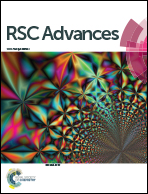Synthesis, electrochemical, fluorescence and antimicrobial studies of 2-chloro-3-amino-1,4-naphthoquinone bearing mononuclear transition metal dithiocarbamate complexes [M{κ2S,S-S2C–piperazine–C2H4N(H)ClNQ}n]†
Abstract
A novel multifunctional ligand precursor 2-chloro-3-{2-(piperazinyl)ethyl}-amino-1,4-naphthoquinone (L) was synthesized by chemo-selective reaction of 2,3-dichloro-1,4-naphthoquinone and 2-(piperazin-1-yl)ethanamine and characterized, prior to use. A series of mononuclear transition metal dithiocarbamate complexes [M{κ2S,S-S2C–piperazine–C2H4N(H)ClNQ}n] {M = Mn(III) 1, Co(III) 2, Ni(II) 3, Cu(II) 4, Zn(II) 5; ClNQ = 2-chloro-1,4-naphthoquinone; n = 3 for 1–2 and n = 2 for 3–5} bearing pendant 2-chloro-3-amino-1,4-naphthoquinone groups were efficiently synthesized through a self-assembly process involving L, CS2 and corresponding metal acetates. 1–5 were characterized by microanalysis and standard spectroscopic methods such as ESI-MS, IR, 1H and 13C NMR and UV-visible absorption spectroscopy. Significantly, all compounds exhibit medium to very strong fluorescence emission bands in the visible region with concomitant Stokes shifts of ≈280 nm upon excitation at their respective λmax values. Thermal stability of complexes 1–5 has been investigated by thermogravimetric analysis. Cyclic voltammetric study clearly reveals that L and 1–5 are electro active with respect to the dominant redox-active naphthoquinone moiety. Further, L and 1–5 were tested against six important pathogen microorganisms viz. S. aureus, B. subtilis, E. coli, P. aeruginosa, C. albicans and A. niger by using the Broth dilution method. A broad spectrum of the strongest antimicrobial activity was determined for the copper(II) complex 4 and L. The enhanced antibacterial activity of L and copper(II) complex 4 against S. aureus apparently reveals them to be a superior antibacterial agent than the reference drug ciprofloxacin.
![Graphical abstract: Synthesis, electrochemical, fluorescence and antimicrobial studies of 2-chloro-3-amino-1,4-naphthoquinone bearing mononuclear transition metal dithiocarbamate complexes [M{κ2S,S-S2C–piperazine–C2H4N(H)ClNQ}n]](/en/Image/Get?imageInfo.ImageType=GA&imageInfo.ImageIdentifier.ManuscriptID=C5RA08065G&imageInfo.ImageIdentifier.Year=2015)

 Please wait while we load your content...
Please wait while we load your content...